Writing a solid survey introduction is not a waste of time.
You’ve created a survey and you need answers.
Preferably without respondents going “NOPE” at seeing the word “survey” in their mailbox.
It’s your one window to get in, create a feeling of sympathy and make people feel like
“Mmkay, I want to help these guys out with my answers”.
In fact, it’ll be the same trigger that pushes you to read this article or not.
(No hard pushes though, just a gentle nudge. OK?)
There are a few essentials that make up an irresistible survey introduction. We’ve collected all of them for you in a useful list and written up a good (copyable!) example of each approach. And one PERFECT template that combines them all.
4 Aspects of writing a solid survey introduction
1. Provide all (relevant) necessary information
Based on what you want to ask and who, choose from the items below.
Don’t write an endless introduction for the sake of being correct.
Limit yourself to giving the essential information, and the trigger that your audience needs to take action.
Let people know:
– What’s your purpose?
If I asked you a bunch of questions, you’d want to know why I’m asking and why I’m asking YOU specifically.
Being clear and transparent about your purpose will help people see you as “someone they can help”.
Give them a chance to be a hero for one day. 😉
Simply state the reason for your survey and what you want to achieve with it, will persuade more people to complete it.

Use this template: We’d really like to find out how you feel about [research topic]
Saying what your purpose is, helps people value your research.
But actually showing what you do with your research, that’ll just draw them right in!
If you have previous results you can refer to and tie this to how people can help you now.
Don’t think, do it!

– Is it private?
Privacy is tricky as it is.
With people becoming more and more aware of the importance of their personal information, it’s necessary that you are up front.
Always be clear about what you plan to do (or not do) with the collected information and you’ll ease respondents into answering more truthfully.
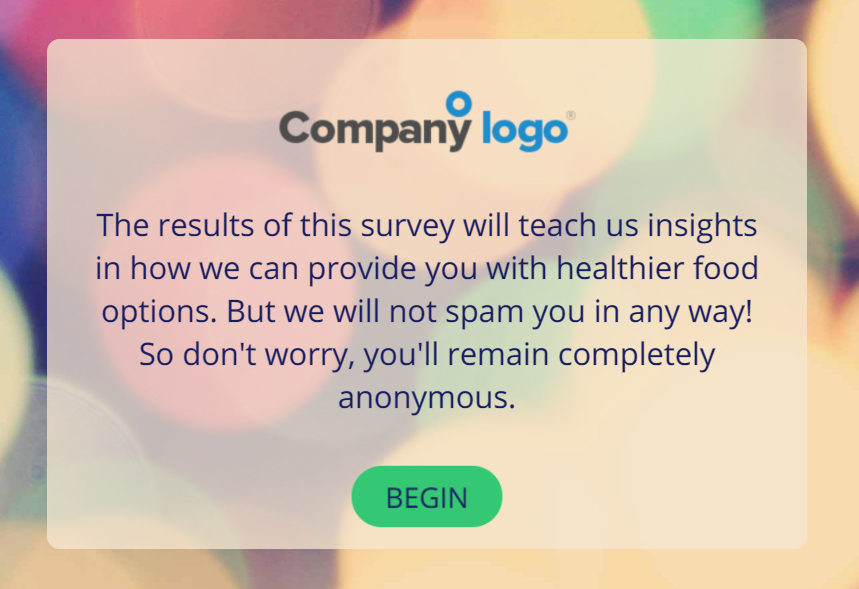
Use this template: No! We don’t want to spam you in any way. So don’t worry, you will remain completely anonymous.
If your respondents aren’t anonymous, be clear to state what will happen to their information and why:
Use this template: We appreciate you letting us know who you are. We don’t want to spam you in any way, the data we collect will be used only for this research.
Extra tip: There’s only so much room in an introduction screen. If you want to be thorough, you can always add a link to your privacy policy in one of the slides before you ask your respondent to submit their answers.
Just in case you do plan to reach out to them afterwards. Always give respondents the option to “opt out”:
Use this template: If you want to be informed about the results of this survey and receive other news from [company name], enter your email here.
– How long will it take?
This is THE most frequently asked question when people take a survey.
Try to give your respondents a realistic estimate of the time it’ll take to answer your questionnaire.
Now let’s be honest!
We both know that your 10 open-ended questions will not get answered if you promised that the survey would only take a minute.
It’s up to you, not only to be honest about the duration, but also to make sure that you limit your survey to the essential questions and no more.
Respondents can and will abandon you for this.
When we send out surveys through email we will always write something along the lines of “This survey will only take 49 seconds of your time. Really! We timed it 😉 “.
(We actually do time it!)
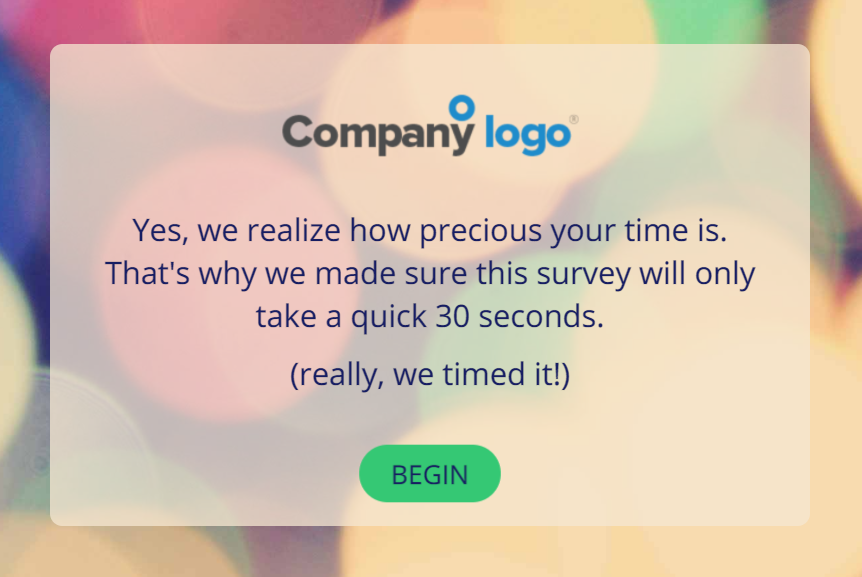
Use this template: We realize how precious your time is. That’s why we made sure this survey will only take a quick [amount of time – preferably in seconds].
– What’s in it for me?
People want to win stuff.
It’s simple.
Winning does not necessarily mean a big prize.
People like to get knowledge in return, have a little fun with a game, get a coupon, …
Incentives are the perfect and easiest way to boost your participation rates.
(Aside from the introduction examples, make sure the incentive is relevant and useful.
Big and expensive does not equal relevance!)
Even people who are initially uninterested can be won over with a well-chosen incentive. Add more power and a little tease by adding a picture or video of the incentive.
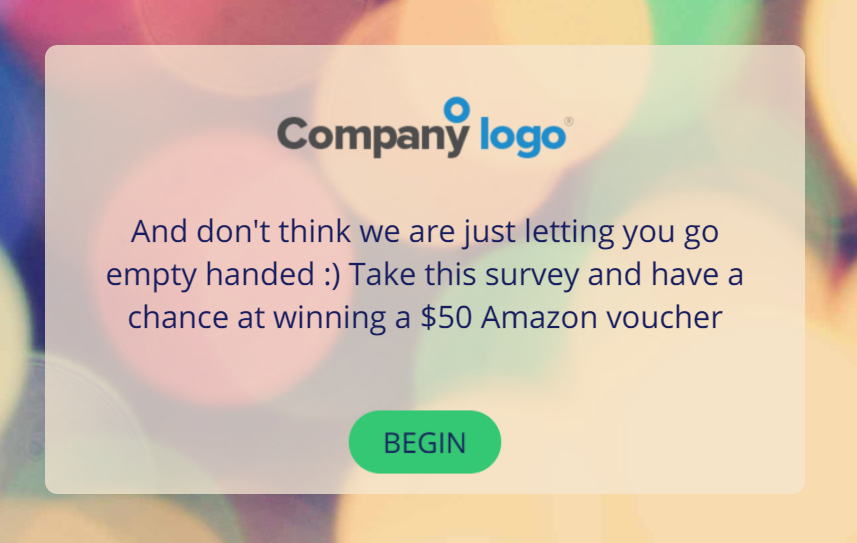
Use this template: Think we were going to let you leave empty handed? 🙂 Take this survey and have a chance at WINNING our big prize [that you should specify here]!
– What audience am I in?
Of course, your survey will have a certain target audience.
So when approaching potential respondents about a survey, make sure to inform them about this chosen target audience.
Quickly let them know why you chose this segment and how your respondent fits in.
It’ll increase their recognition of how they can help you personally.
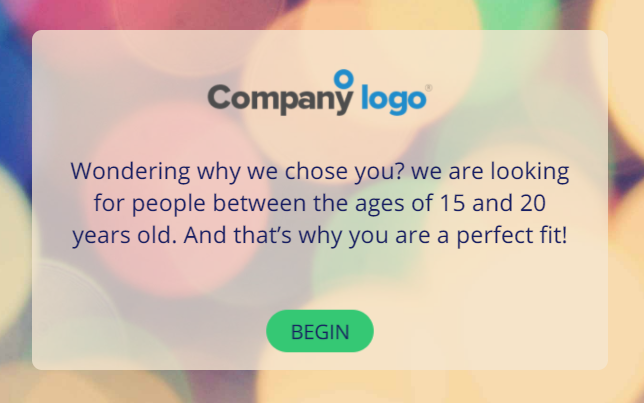
Use this template: Wondering why we chose you? We’re looking for [that which specifies your target audience]. And that’s why you’re a perfect fit!
– Who am I answering these questions for?
Knowing from which company the survey originates is another way of convincing your target audience.
Give some basic information about yourself as participants will be more reluctant to share any data with an unknown company.
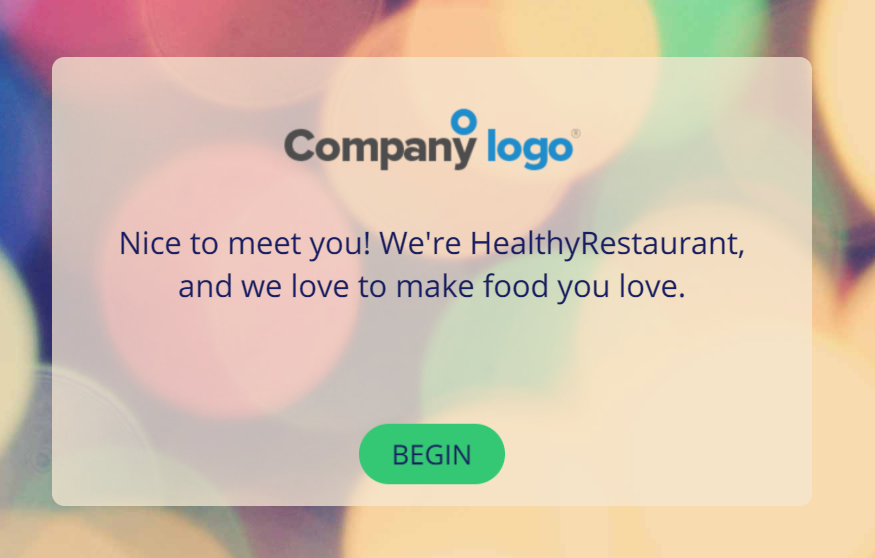
Use this template: Nice to meet you! We are [company name] and [a little bit more about your company, or jump straight to the purpose of your research]
2. A simple thank you
Power up your survey introduction with a thank you note.
Hey, it’s not only a sign of appreciation, it’s the least you can do!
Your participants are giving up their time for you to benefit from.
They are not gaining anything from doing this (except maybe your super relevant incentive). Try your best to make this experience as human and “spontaneous” as possible by adding a personal touch, especially by thanking your respondents.
(Thank you, by the way. You’re doing an awesome job reading all the way to the end… )
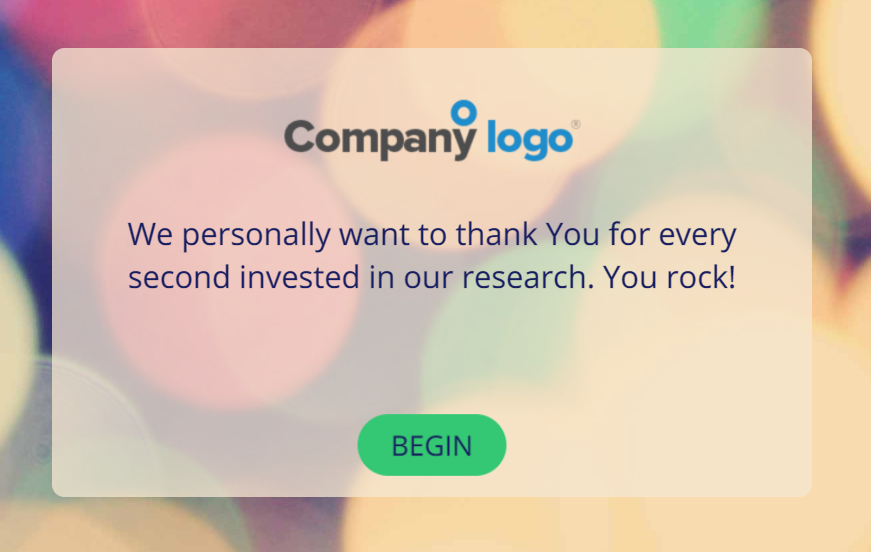
Use this template: We personally want to thank YOU for every second invested in our research. You rock!
If your company and research allows it, make this even more personal.
Give your brand a face.
Adding a real person’s name works just as well in surveys as it does in a newsletter, blog post or podcast.
Use this template: Thanks for helping us out. From all of us at [company name], [your name] [your title (optional)]
3. Less is more
Take everything you’ve learned in the previous steps…
And now scratch that!
Because a little less will do.
We recommend to always write your survey introduction text as short as possible.
????
… Sorry, I know!
People – especially those in a hurry – don’t want to waste their time reading page-long introductions before finally being able to start your survey. Use only the essentials from the above tips. Then go ahead and just make your point.
By writing up your survey introduction as short as possible, you force yourself to only focus on the most important message. And you don’t waste respondents’ time even before they’ve taken the survey. Getting them in is what’s most important.
Tip: If you want to analyze the way users read your surveys in order to predict their performance more accurately, maybe one of the AI consulting tools we looked at, Neurons, has what you need.
4. Inviting atmosphere is key
The first step for your introduction is making sure people will enter your survey and answer questions. Your second priority, is making sure they’re honest.
Here’s how to get that done:
Honesty: “You get what you give. What you put into things is what you get out of them.” – Jennifer Lopez.
Don’t expect your participants to blindly answer in a truthful way if they don’t know the full picture surrounding your study. Offer all corresponding information from the very beginning to avoid sloppy data which could lead to “brand dilution”.
Neutrality: Try to remain neutral throughout your entire survey, not just your introduction. You often see companies using one liners like “leading company in our niche” or “Bringing you the best service”. Don’t do this! As it will only create confusion and prejudice instead of confidence and reliable data.
Now let’s summarize, and get to the good stuff:
The perfect survey introduction example
Followed all of the steps above? Nice!
You will have a survey introduction that is perfect and by the book!
Does it look like it got a bit too long?
Too much info?
Simply not as appealing as you thought it would be?
We wrote up a short, generic and to-the-point version for you to use. The perfect survey introduction example:
Use the ultimate template:
Hey, glad to see you around here!
First of all, let me thank you for taking our [survey duration] survey. You are a great help! 🙂
We at [company name] are on a daring quest to collect the right data about [survey subject]. Our target audience involves everyone who [target audience]. This is why we chose you!
And don’t worry, your data is just for [where you will use it] ]so [be clear about their privacy]. We promise!
– Get started and take your chance to WIN [a grand prize]
It’s most important to make this introduction represent you as a brand, organization or person.
It’s the first step of starting up a conversation.
And don’t be afraid to entertain: Don’t bore, get more. 😉
Extra tips & inspiring introduction examples
1. Increase brand recognition
Hey it’s you!
By adding your logo at the top of your intro screen, you’ll increase brand recognition without having to push it forward during the entire survey.
Make people feel like they’re talking to an old friend.
2. Use a conversational tone
Most people still associate surveys with these boring tasks that are basically – let’s face it – a waste of their time.
Spice up your language and bring some humanity into your questions.
Making your surveys more conversational will benefit your participation and completion rate tremendously!
EXTRA: If your brand and tone of voice allow it, throw in an interjection here and there. A “yee-hah” to show joy or an “ooh-la-la” to let respondents know they can win a prize?
Works like a charm.
Take a look at this list of interjections, for exclamations in every kind of situation.
3. Turn a frown upside down with emoticons
Go back 15 years in time and nobody would even THINK of using a smiley face.
Well, that period is over and now it’s totally fine.
🙂
In fact, did you know that the use of emoticons in your communication increases the empathy towards your brand?
Perfect to express the mood of your survey, if your message is a playful one.
4. What’s in a name? Don’t use the word “survey”
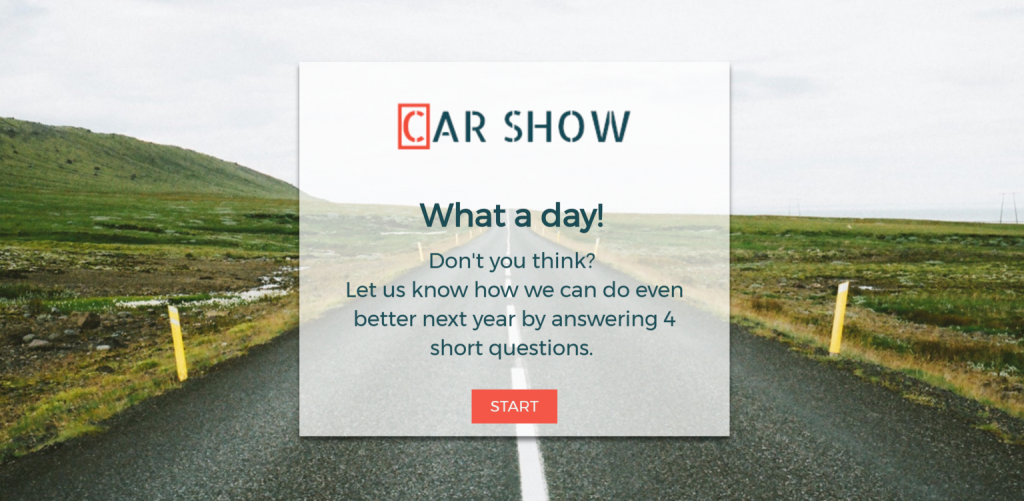
Long, boring, difficult, too much work, … the word “survey” brings out some awful associations. We cannot blame our respondents. Instead, ask people to answer “a few questions” or to “spare a minute of their time”.
By avoiding the actual word you’ll see an increase in clicks and actual responses. This works in the introduction screen of your questionnaire, but in your email invites as well for example.
Keep in mind though that you should stick to just 4 questions if that’s what you said!
5. Show off the (incentive) goodies

A reward for answering a couple of questions lowers the threshold tremendously! Even more so if there’s a game or contest connected to the reward. The thrill of playing and possibly winning something is a perfect addition to your survey introduction.
6. In all seriousness
There’s a time and place for everything, so if your questionnaire is much too serious for smileys or “whoopees”, you can still write up a longer introduction that eases the respondent into the setup.
A competency assessment, like the above example, is something that requires more information. They managed to put quite a lot of it in the introduction, but decided to refer to an informative page via a hyperlink in case an employee would like to read up before getting started.


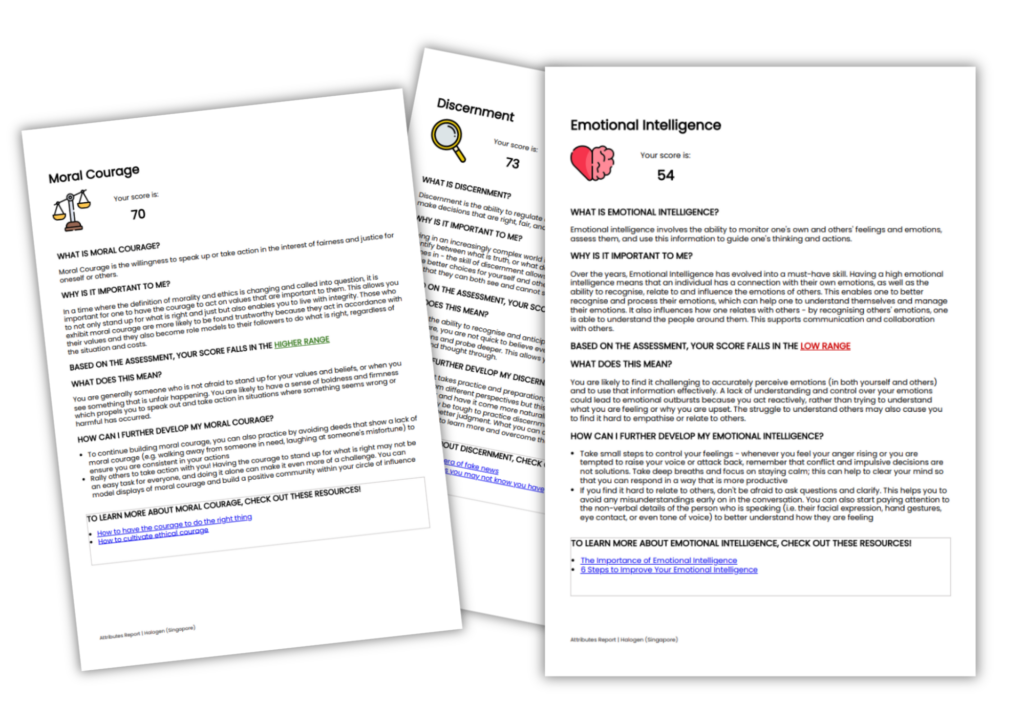




10 Responses
Great tips to help get engagement and not sound like one more boring request for info
Thank you for taking the time to offer this guidance.
One of the great article! Precise and Clear Information, Kudos!!!
I should have read this in the past. I could have a great format. Thank you!
Thanks a lot. This will really help me.
Fruitful & eye opening. Thank you very much.
Thank you for your fantastic tips.
Great Tips. Took something away. Always good.
Quite helpful for a lively sourcing of needed information. Thank you lots.
Thanks for sharing!